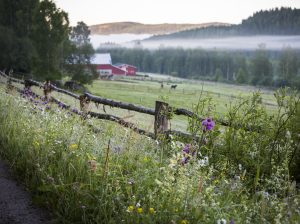Author: Tarja Kupiainen, Karelia University of Applied Sciences

Nature has traditionally been an attraction for Finnish tourism. The peace and quiet of Eastern Finland appeal especially to tourists from congested areas. In addition to the natural landscape, the Ilomantsi area is attracted by its rich oral tradition: the ancient poetry culture has flourished there through the centuries. It is the tradition that underlies the national epic Kalevala (older, narrower version 1835, the actual national epic 1849).
The ancient Finnish-Karelian singing tradition is called “rune singing”. The word ‘rune’ refers in two directions: to the Finnish word ‘runo’ = poem and to the sage for the ‘runo’ in the old language has meant just the sage, seer, or shaman. This creates a mythical background or tone to the Finnish-Karelian custom of singing. Because the Kalevala is considered world-famous, the old singing tradition is called the Kalevala poetry.
Kalevala poetry differs from other singing traditions, such as laments or rhyming songs, in that it has its own special archaic features, such as the typical four-footed trochee measure called “Kalevala-measure”. Kalevala-measure folk poetry can be divided into narrative or epic poetry, sentimental or lyric poetry, and ritual poetry, which includes wedding poems, bear ceremony incantations, and spells. In Ilomantsi, all of these were a living tradition until the 20th century. However, still today in Ilomantsi it is possible to hear traditional singing and playing skillfully performed.
Poem singing traditions
With the exception of magical spells, Kalevala poetry was performed singing. Until the 20th century, the rune singing remained as two different traditions. In the southern areas – the Karelian Isthmus, Ingria, and Estonia – the songs were performed by a chorus led by a lead singer. In the northern areas – to which Ilomantsi belongs together with Archangel Karelia, Olonets, and Ladoga Karelia – the songs were usually performed as solos or by small groups of two or three singers singing in unison.
It should be noted that the songs were not only performed in ritual contexts, but were part of everyday life in Ilomantsi. Women sang while weaving, and men when making fishing nets. The poetry singing culture has been considered primarily a male tradition, but even children knew poems. Men sang the ancient heroic poems about Väinämöinen, Joukahainen, and Lemminkäinen. Women’s traditional poetry consisted of ballads about wooing and love, lyric songs, and above all laments or ritual weeping. However, there is no clear-cut difference between male and female songs.
A significant shift in the rune singing culture took place was in the year of 1964: the Runonlaulajan pirtti (Rune singer’s cabin in bardic village) in Parppeinvaara, Ilomantsi was established. As a Karelian cultural centre the Pirtti was dedicated to the last generations of rune singers. Following this dedication, the Runonlaulajan pirtti served as a stage for occasional performances of vocal and instrumental music. Since 1977, musical performances have been offered on a daily basis during the summer season.
At Parppeinvaara, it is now possible to visit the sheds of a master of lyrical poetry
Mateli Kuivalatar (1771 – 1846). Elias Lönnrot, who composed the Kalevala by combining different poetic materials and themes, met her during his visit to Ilomantsi. Mateli sang several songs for Lönnrot, the themes of which ranged from lyric to mythical themes. Mateli’s versatile and skillful verses can be found on the pages of Kanteletar. Today, for example, Liisa Matveinen, who comes from Ilomantsi and has returned there, performs Mateli’s songs. She has even recorded them with her colleague Tellu Turkka.
The singer was a sage
The current perception of the rune singer is relatively new and romanticized. As stated earlier, in the native Karelian vocabulary, however, the terms ‘runo’ and ‘runoi’ stood for seer, shaman, or singer. The early singers of the ancient poetry themselves referred to their poems as ‘virret’ (“hymns”). “Singing” referred formerly to incantation, and the singer was a person of primordial knowledge, a holder of magical words. Sometimes the same poem could function as both a spell and a song depending on the context. When a healer, i.e. a sage was needed, there may not have been time to begin singing a long poem. Therefore, the poem had to be recited in a minute, where singing it might take much longer.
Folk healers were persons who worked outside of official medicine. Up to the 19th century, rural villages had experts on various types of complaints: cuppers, massagers, snakebite healers, sprain tiers, love magic specialists, medicinal herbalists. The most difficult cases went to the seer. One of the most famous seers, Simana Sissonen (1786 – 1848) influenced Ilomantsi’s Mekrijärvi. He possessed the secret knowledge that made him able to stop bleeding, for example. Like other healers and seers, he was a powerful and esteemed person in his own community.
In Ilomantsi, today, the tourist can still sense echoes of the ancient poetic tradition. While enjoying the beautiful scenery, you can hear rune singing in the breeze of the wind. In addition, you can enjoy authentic traditional singing and playing in Parppeinvaara Bardic Village. Welcome to Ilomantsi!
It is a great pleasure to inform that we will continue the development of Ilomantsi cultural tourism started in the SHAPE project in the new project “Voyage to mythology – Kalevala” financed by the European Regional Development Fund (ERDF).



